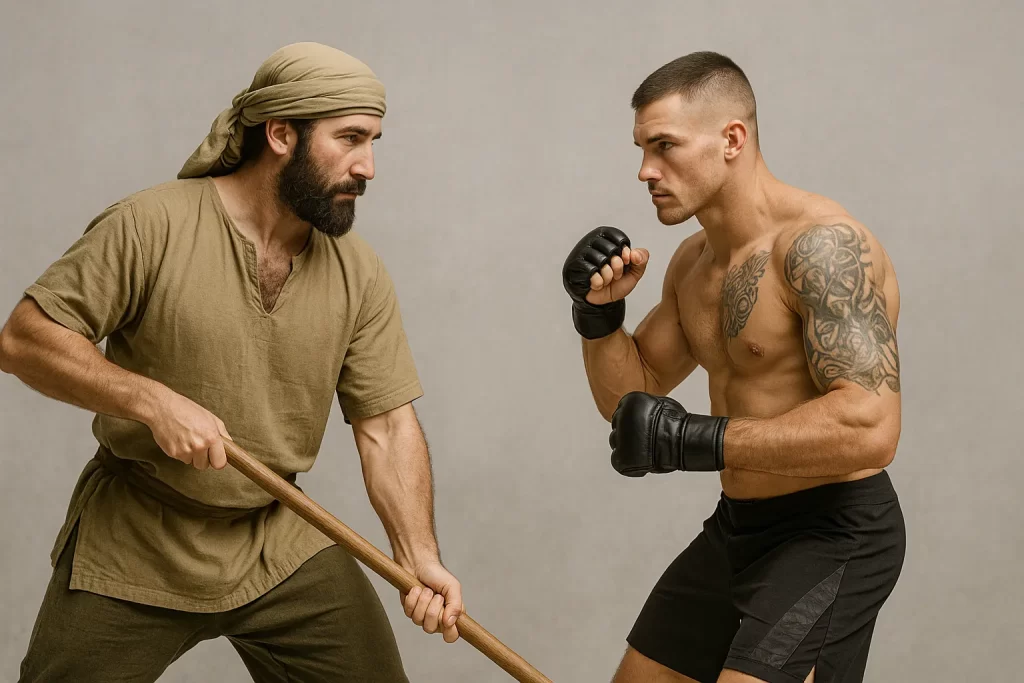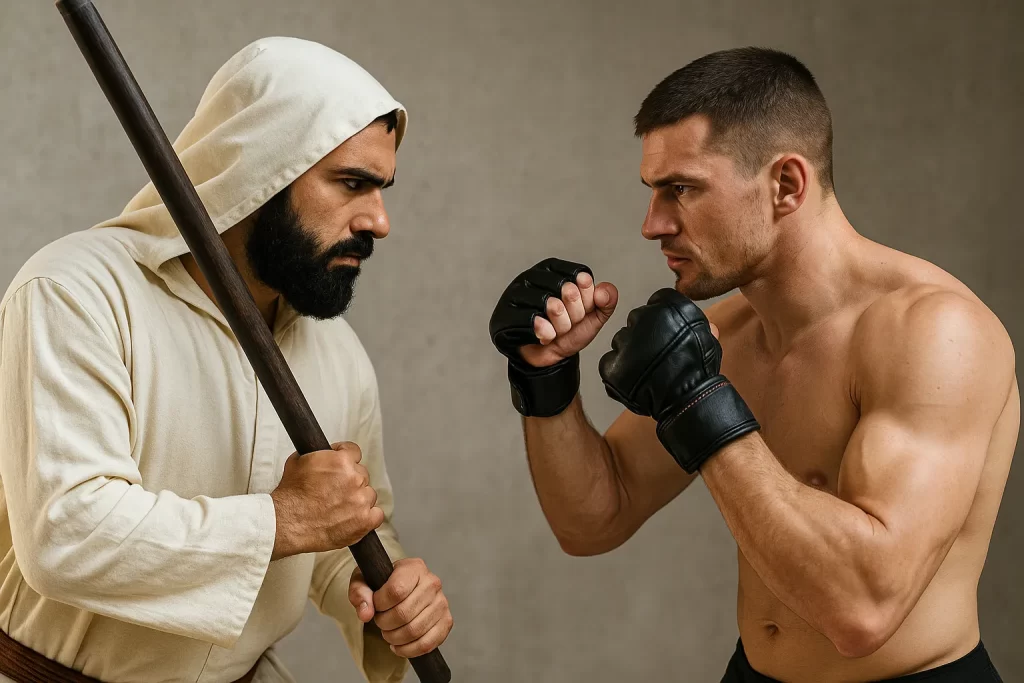The Foundations and Form of Tahtib
Historical and Cultural Roots
Tahtib, originating from ancient Egypt, began as a ceremonial and martial stick-fighting discipline. While modern adaptations (such as Modern Tahtib) attempt to revive its combative practicality, traditional Tahtib has long served dual purposes: martial readiness and ritualistic expression. The core of Tahtib lies in fluid, circular stick maneuvers rooted in tribal choreography and battlefield preparation.
Unlike many combative systems designed primarily for striking or grappling, Tahtib employs long-range stick control and angular evasion. Fighters maintain an upright, proud posture, often reflecting its performative heritage. Yet underneath the ritual lies a combat logic: exploiting distance, rhythm disruption, and timing.
Combat Mechanics and Technique
Tahtib emphasizes rotational power, especially via full-body hip engagement. A basic offensive sequence includes overhead arcs, sudden low-line sweeps, and redirections mid-swing. Defensive movement relies less on parrying and more on voiding the line of attack — retreating or angling with body shifts rather than engaging directly.
Biomechanically, Tahtib fighters develop spatial awareness and rotational momentum through repetitive drills involving footwork triangles and spin recovery. The cognitive side is just as critical: fighters must read intentions based on body shifts, not just the weapon path.
Training Format and Pedagogy
Traditional Tahtib training involves paired drills and semi-choreographed exchanges — often accompanied by rhythmic music. Modern adaptations emphasize structured sparring and individualized coaching.
A typical session focuses on:
- Core footwork loops (triangular and circular patterns)
- Reflexive stick control drills
- Controlled sparring that escalates in intensity
The lack of protective gear traditionally fosters a culture of control and mutual respect rather than brute force.
Philosophy and Mindset
Tahtib embodies a warrior-gentleman ethos. Combat is seen as a dialogue, not domination. Restraint and elegance are valued over aggression, aligning with its heritage of ceremonial duels during village festivals.
The core philosophical tenets include:
- Honor through measured action
- Mastery of rhythm and tempo as mental discipline
- Adaptation as proof of understanding, not just strength
This positions Tahtib not only as a fighting style, but also a method of internal regulation — useful for managing stress and cultivating social poise.
Practical Benefits in Everyday Life
While stick-based systems may appear archaic, Tahtib develops several highly transferable attributes:
- Postural integrity and coordination, reducing injury risks in daily life
- Timing-based reflexes, valuable in traffic scenarios, sports, or physical tasks
- Emotional regulation under pressure, fostered through sparring without excessive contact
- Rhythmic movement competence, improving balance and gait
For practitioners in modern urban environments, Tahtib offers non-lethal self-defense foundations (e.g. using everyday items as proxies for a stick) and a low-impact training modality accessible across age groups.
Requirements and Accessibility
Tahtib has relatively low entry barriers:
- No need for extensive strength or flexibility
- Equipment is minimal (a wooden stick suffices)
- Sessions can be short, yet neurologically rich
It’s ideal for those interested in expressive martial arts, low-impact combatives, or tradition-rooted practices that serve both mind and body.
The Structure and Demands of MMA (Mixed Martial Arts)
Origins and Philosophical Premise
MMA, as a sport and training method, integrates multiple martial arts into a single, competitive format. Rooted in the desire to identify the most effective combat style, it has evolved into a rule-based sport that demands cross-disciplinary excellence — combining striking, wrestling, and submission grappling.
The MMA ethos is pragmatic: efficiency, adaptability, and performance. There’s little tolerance for ceremonial excess; instead, the focus lies on measurable dominance under pressure.
Combat Mechanics and Techniques
MMA operates within four major domains:
- Striking: boxing, Muay Thai, kickboxing
- Clinch fighting: Greco-Roman wrestling, dirty boxing
- Takedowns: Judo throws, wrestling shots
- Ground control and submissions: BJJ, Sambo, catch wrestling
This layered system requires fighters to fluidly transition between ranges. For instance, an MMA fighter might throw a leg kick, enter a double-leg takedown, pass guard, and apply a rear naked choke — all within seconds.
Biomechanically, MMA demands:
- Explosive power (sprinting and grappling)
- Neuromuscular reactivity (striking defense)
- Isometric endurance (clinching and submissions)
- Multi-planar movement intelligence (to maintain balance during scrambles)
The body must perform under high-stakes anaerobic conditions with minimal recovery time.
Training Methodology
An MMA camp consists of multiple modules:
- Striking practice (pads, bag work, sparring)
- Grappling sessions (BJJ rolls, wrestling drills)
- Conditioning (circuit training, sprint intervals, heavy lifting)
- Game-planning and video analysis
Athletes may train up to 6 days a week, often with multiple daily sessions. Technical skill is matched with cardiovascular and mental resilience.
Injuries are common, and so is performance burnout — making periodization and recovery science crucial to long-term participation.
Philosophy and Mental Framework
MMA doesn’t espouse a singular moral code. Instead, its philosophy stems from:
- Empirical performance: What works is good
- Constant evolution: No style is untouchable
- Accountability through competition
Unlike traditional arts rooted in culture or ritual, MMA adopts a sport-science and individualistic lens, shaped by performance metrics, fight records, and real-time adaptation.
However, successful fighters often embrace deeper mental frameworks borrowed from psychology, Stoicism, or traditional discipline — recognizing that resilience, focus, and emotional control win as many fights as physical dominance.
Relevance in Real Life
MMA’s transferability depends on the practitioner’s context:
- For security professionals, its multidimensional training prepares for unpredictable threats.
- For civilians, some techniques (e.g. ground grappling) may be impractical in street scenarios due to environmental constraints or legal issues.
Nevertheless, MMA practitioners often:
- Exhibit peak physical fitness across metrics (VO2 max, mobility, strength)
- Gain emotional regulation skills under duress
- Improve situational awareness, crucial for de-escalation and assertiveness
It also fosters a growth mindset: improvement is constant, and no technique is immune to scrutiny.
Prerequisites and Entry Demands
MMA has high demands:
- Requires baseline athleticism or willingness to develop it
- Needs access to multiple disciplines and coaches
- May involve high costs (gear, gym memberships, medical insurance)
- Risk of injury is significantly higher than traditional systems
For the committed learner, however, MMA offers a battle-tested curriculum that refines both body and mind — but it is rarely sustainable without structured recovery and lifestyle alignment.
Comparing Tahtib and MMA in Structured Environments

Gym-Based Training and Competitive Practice
In controlled environments such as dojos, gyms, or training halls, both Tahtib and MMA present distinct strengths and limitations — shaped by their format, contact intensity, and training goals.
Tahtib in the Dojo or Cultural Center
Modern Tahtib is often practiced in cultural centers, martial arts studios, or outdoors in traditional settings. The training is:
- Partner-based, but mostly non-contact or light-contact
- Rooted in rhythmic sparring exchanges, often timed to music
- Emphasizes flow, timing, and aesthetic form
Competitive aspects are minimal, though some modern clubs conduct friendly matches with protective gear. Matches are judged based on control, technique execution, and rhythm rather than brute impact or point accumulation.
The result is a low-pressure, coordination-driven environment, which supports learning through repetition and observation. Feedback is usually communal, encouraging shared improvement rather than individual triumph.
MMA in the Gym or Cage
MMA gyms follow a far more performance-driven paradigm. Training is segmented into:
- High-intensity striking drills, often against resistance
- Clinch and takedown practice, sometimes with full resistance
- Live sparring rounds, with or without protective gear
Competition is central: whether in amateur leagues, grappling tournaments, or professional circuits, fighters are evaluated based on effectiveness under pressure. Even hobbyists often participate in light sparring or mock scenarios.
MMA training environments foster a competitive mindset, where technical failure can result in physical consequences. Mistakes are corrected through immediate feedback, often during live combat drills.
Training Dynamics: Cooperation vs. Competition
| Aspect | Tahtib | MMA |
|---|---|---|
| Contact level | Light to medium (ceremonial focus) | Medium to full (combat simulation) |
| Feedback mechanism | Group-based, rhythmic corrections | Coach-led, technical and critical |
| Focus | Form, rhythm, expression | Functionality, speed, damage control |
| Equipment needed | Stick, light attire | Gloves, pads, mats, mouthguard |
| Social structure | Egalitarian, often communal | Hierarchical, coach-athlete system |
In terms of injury risk, Tahtib is significantly safer, making it more suitable for low-impact, sustained learning. MMA, while physically rewarding, carries higher risks — including concussions, joint injuries, and burnout — particularly in advanced sparring.
Real-Life Applications: Utility in Everyday Contexts
Situational Analysis: Self-Defense and Conflict Resolution
Scenario 1: Urban Altercation (Street-level aggression)
- Tahtib’s Approach: Tahtib provides long-range threat deterrence through stick mobility, making it useful in situations where an improvised object (umbrella, cane, broomstick) is available. Techniques focus on redirecting rather than crushing the opponent. Example: A circular side swing (using hip torque) aimed at the attacker’s hand or arm can disarm or disable with minimal escalation.
- MMA’s Approach: MMA prepares practitioners for close-quarters confrontations — tackling, clinching, and controlling the opponent on the ground. A front kick to create space or a double-leg takedown to subdue the attacker would be primary responses. Example: In a confined hallway, an MMA-trained individual could perform a body lock takedown and control the aggressor from a mounted position.
Analysis:
- Tahtib excels in situations with space and available tools, emphasizing non-lethal distancing techniques.
- MMA thrives in constrained settings, offering total engagement tools — but with higher legal and ethical implications in over-application of force.
Scenario 2: Group Training in Schools or Senior Centers
- Tahtib’s Format: Can be adapted for youth or seniors, emphasizing mobility, balance, and coordination. Often practiced in group formations, it strengthens social interaction and rhythm awareness.
- MMA’s Format: While adapted kids’ MMA programs exist, the intensity and complexity of multi-style transitions make it better suited to adolescents and young adults. Seniors may engage in isolated components (e.g. no-contact pad work), but full integration is rare.
Conclusion:
- Tahtib is better for communal, lifelong movement training.
- MMA is better for young adults seeking intense fitness and competition.
Key Technical Differences in Movement and Execution
Tahtib Techniques
- Circular Forearm Loop: A fast spinning arc from high guard, used to deflect or dissuade
- Step-and-Sway Pivot: Evades incoming attacks by displacing centerline laterally
- Wrist Control Binds: Light gripping techniques to trap and redirect
These techniques rarely involve body-to-body contact, focusing instead on space control and fluidity.
MMA Techniques
- Inside Low Kick: Used to off-balance an opponent, common in entry setups
- Clinch Elbow Strike: A close-range attack exploiting leverage in the tie-up
- Guard Pass to Armbar: A grappling sequence ending in joint manipulation
MMA emphasizes multi-phase continuity — striking, transitioning, controlling, finishing.
Age Suitability: A Functional Comparison
Children and Adolescents (6–17)
- Tahtib:
- Excellent for motor development and rhythm
- Low injury risk
- Builds early respect for personal space and coordination
- MMA:
- High engagement, ideal for discipline, confidence, fitness
- Needs careful coaching to avoid injury
- May be overstimulating for very young children due to complexity
Verdict: Tahtib is safer and more developmental under age 12; MMA suits structured teen programs (13+).
Young Adults (18–35)
- Tahtib:
- Appeals to those seeking cultural martial exploration
- Less physically demanding, good for cross-training
- MMA:
- Ideal for physical peak years
- Demands high recovery capacity, but yields fastest skill acquisition
Verdict: MMA dominates this age bracket for competitive and fitness reasons; Tahtib complements it as a mobility/awareness practice.
Adults and Seniors (36–65+)
- Tahtib:
- Sustainable for long-term training
- Enhances cognitive and balance skills
- MMA:
- Limited to non-contact versions (e.g. fitness-based striking, light grappling)
- Injury risk rises steeply beyond 40 if unmanaged
Verdict: Tahtib remains accessible and safe at later ages. MMA requires major modifications or segmentation (e.g. BJJ-only, kickboxing drills only).
Closing Perspective
Where Tahtib shines is in its accessibility, cultural richness, and adaptability across ages — especially when the goal is movement literacy, mental balance, and graceful self-defense.
Where MMA excels is in its comprehensive fight-readiness, peak athletic development, and tactical versatility — but it demands significant physical, mental, and lifestyle commitment.


